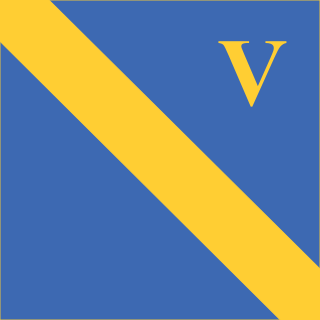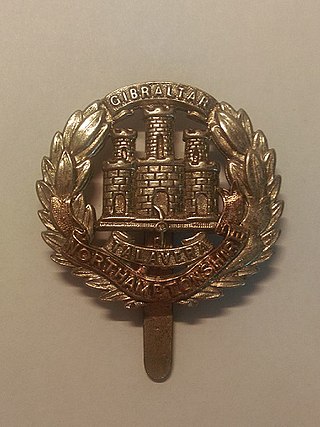
The 5th Infantry Division was a regular army infantry division of the British Army. It was established by Arthur Wellesley, 1st Duke of Wellington for service in the Peninsular War, as part of the Anglo-Portuguese Army, and was active for most of the period since, including the First World War and the Second World War and was disbanded soon after. The division was reformed in 1995 as an administrative division covering Wales and the English regions of West Midlands, East Midlands and East. Its headquarters were in Shrewsbury. It was disbanded on 1 April 2012.

The Lancashire Fusiliers was a line infantry regiment of the British Army that saw distinguished service through many years and wars, including the Second Boer War, the First and Second World Wars, and had many different titles throughout its 280 years of existence. In 1968 the regiment was amalgamated with the other regiments of the Fusilier Brigade – the Royal Northumberland Fusiliers, Royal Warwickshire Fusiliers and the Royal Fusiliers – to form the current Royal Regiment of Fusiliers.

The 48th Division was an infantry division of the British Army. Part of the Territorial Force (TF) and raised in 1908, the division was originally called the South Midland Division, and was redesignated as the 48th Division in 1915. During the First World War, the division saw service on the Western Front before being transferred to the Italian Front in November 1917 and remaining there for the rest of the war.

The Royal Warwickshire Regiment, previously titled the 6th Regiment of Foot, was a line infantry regiment of the British Army in continuous existence for 283 years. The regiment saw service in many conflicts and wars, including the Second Boer War and both the First and Second World Wars. On 1 May 1963, the regiment was re-titled, for the final time, as the Royal Warwickshire Fusiliers and became part of the Fusilier Brigade.

The 145th Infantry Brigade was a regional brigade of the British Army that saw active service in both the First and the Second World Wars, disbanding in 1943 and being reformed in the 1990s. The Brigade was renamed Headquarters 11th Infantry Brigade and Headquarters South East in October 2014.

The Northamptonshire Regiment was a line infantry regiment of the British Army in existence from 1881 until 1960. In 1960, it was amalgamated with the Royal Lincolnshire Regiment to form the 2nd East Anglian Regiment, which was amalgamated with the 1st East Anglian Regiment, the 3rd East Anglian Regiment and the Royal Leicestershire Regiment to form the present Royal Anglian Regiment.
The 168th Brigade was an infantry brigade formation of the British Army that saw service during both the First and the Second World Wars. Throughout its existence, serving under many different titles and designations, the brigade was an integral part of the 56th (London) Infantry Division. It served on the Western Front during First World War and in the Italian Campaign during the Second World War. It was finally disbanded in the 1960s.

The 146th Infantry Brigade was an infantry brigade formation of the British Army, part of the Territorial Force with the 49th Infantry Division. The brigade saw active service during both the First and the Second World Wars, and during the early part of the Cold War. The brigade was active from 1908 until 1967 when it was finally disbanded. The brigade was reformed in 1983, though with a much smaller and insignificant role before finally disbanding again in 1993.

The 147th Infantry Brigade was an infantry brigade of the British Army, part of the Territorial Force, that served in both the First and the Second World Wars with the 49th Infantry Division.

The East Midland Brigade was an infantry brigade of the Territorial Force, part of the British Army, that was raised in 1908. As the name suggests, it commanded infantry battalions recruited in the East Midlands of England: Bedfordshire, Northamptonshire, Cambridgeshire and Hertfordshire. The brigade was an integral part of the East Anglian Division.
The 197th Brigade was an infantry brigade formation of the British Army that saw distinguished active service in both the First and Second world wars.
The 182nd Brigade was an infantry brigade of the British Army that saw active service in the First World War with the 61st Division. It remained in the United Kingdom throughout the Second World War, serving with the 61st Infantry Division.
The 184th Brigade was an infantry brigade formation of the British Army raise for service in both the First and the Second World Wars.
The 32nd (Midland) Anti-Aircraft Brigade was an air defence formation of Anti-Aircraft Command in Britain's Territorial Army (TA) from 1936 to 1955, charged with defending the East Midlands of England.
The Birmingham Rifles was a volunteer unit of the British Army founded in Birmingham in 1859. As the 5th Battalion, Royal Warwickshire Regiment, it served as infantry on the Western Front and in Italy during World War I. Its successor units served in air defence during the early part of World War II, and later as anti-tank gunners in the Burma Campaign.
The 138th Brigade was an infantry brigade of the British Army that saw active service in the First World War with the 46th Division. The brigade again saw active service in the Second World War, with the 46th Infantry Division.

The 148th Infantry Brigade was an infantry brigade formation of the British Army that served in both the First and briefly in the Second World War as part of the 49th Infantry Division and disbanded after the war.
The 144th Infantry Brigade was an infantry brigade of the British Army that saw active service in the First World War and again in the early stages of the Second World War before being reduced to a reserve brigade and remained in the United Kingdom for the rest of the war. In both world wars the brigade served with 48th Division.
The Huntingdonshire Cyclist Battalion was a bicycle infantry battalion of the British Army. Formed in the Territorial Force in February 1914, it remained in the United Kingdom throughout the First World War. After the war, in 1920, it was converted to infantry and became the 5th (Huntingdonshire) Battalion, Northamptonshire Regiment, in the Territorial Army. The battalion saw extensive service in the Second World War, fighting in France in 1940, Tunisia from 1942–43 and later Sicily and Italy from 1943–45 before ending the war in May 1945 in Austria. It continued to serve after the Second World War until May 1961 when it was amalgamated with the 4th Battalion, Northamptonshire Regiment, to form the 4th/5th Battalion, Northamptonshire Regiment.
The 139th Brigade was an infantry brigade of the British Army that saw active service in the First World War with the 46th Division. Later designated the 139th Infantry Brigade, the brigade also saw service with the 46th Infantry Division in the Second World War.












